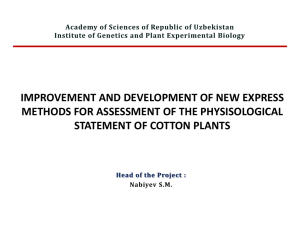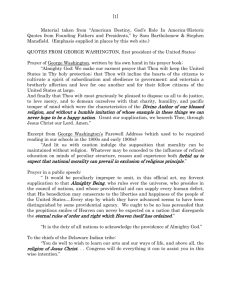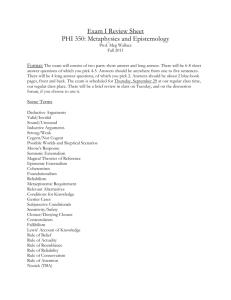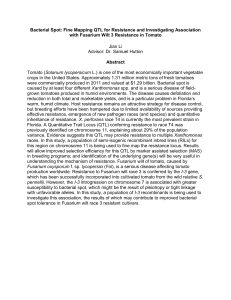The big problem of Wilt Chamberlain
advertisement
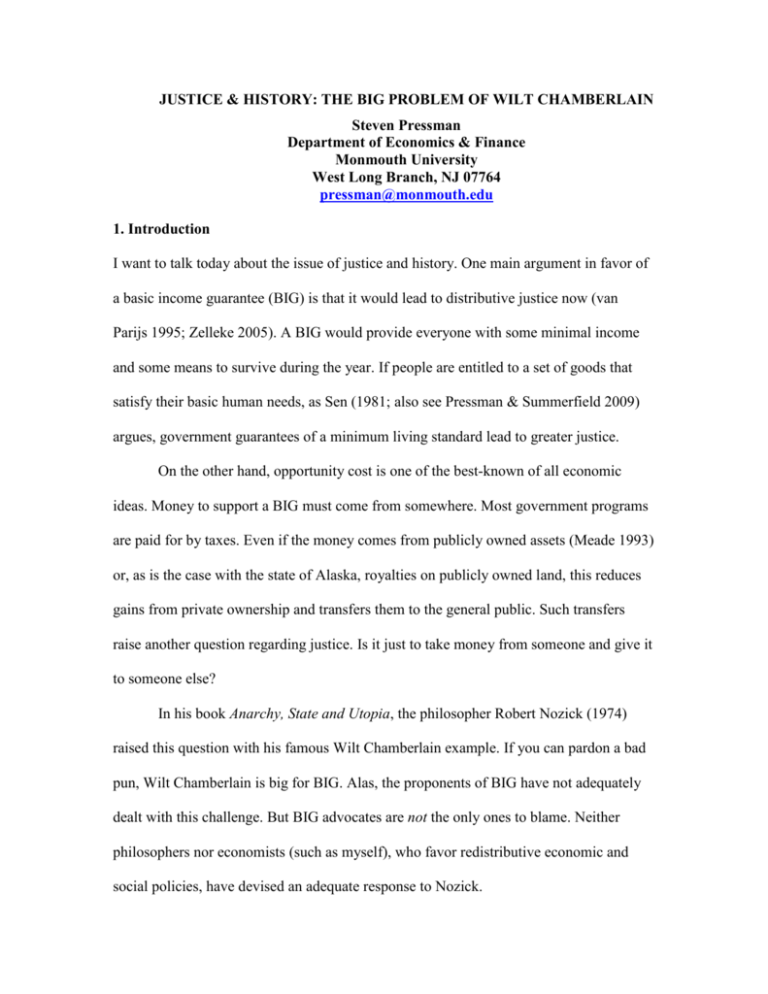
JUSTICE & HISTORY: THE BIG PROBLEM OF WILT CHAMBERLAIN Steven Pressman Department of Economics & Finance Monmouth University West Long Branch, NJ 07764 pressman@monmouth.edu 1. Introduction I want to talk today about the issue of justice and history. One main argument in favor of a basic income guarantee (BIG) is that it would lead to distributive justice now (van Parijs 1995; Zelleke 2005). A BIG would provide everyone with some minimal income and some means to survive during the year. If people are entitled to a set of goods that satisfy their basic human needs, as Sen (1981; also see Pressman & Summerfield 2009) argues, government guarantees of a minimum living standard lead to greater justice. On the other hand, opportunity cost is one of the best-known of all economic ideas. Money to support a BIG must come from somewhere. Most government programs are paid for by taxes. Even if the money comes from publicly owned assets (Meade 1993) or, as is the case with the state of Alaska, royalties on publicly owned land, this reduces gains from private ownership and transfers them to the general public. Such transfers raise another question regarding justice. Is it just to take money from someone and give it to someone else? In his book Anarchy, State and Utopia, the philosopher Robert Nozick (1974) raised this question with his famous Wilt Chamberlain example. If you can pardon a bad pun, Wilt Chamberlain is big for BIG. Alas, the proponents of BIG have not adequately dealt with this challenge. But BIG advocates are not the only ones to blame. Neither philosophers nor economists (such as myself), who favor redistributive economic and social policies, have devised an adequate response to Nozick. 2 In my talk I will develop a rebuttal to the Wilt Chamberlain example and then draw out some of its policy implications. But first we turn to Nozick’s argument. 2. The Wilt Chamberlain Example Wilton “Wilt” Chamberlain was a seven-foot one-inch basketball player, who played for several professional NBA teams from 1959 to 1973. He holds numerous scoring records, including the highest point average for a season (50.4 points in 1961-62) and the remarkable feat of scoring 100 points in a single game in 1962. He was a basketball force to be reckoned with. Nozick (1974, p. 161ff.) uses the dominance of Chamberlain on the court and our desire to see him play to argue against redistributive tax and spending policies on philosophical grounds. His case is rather simple. Many people would love to watch Wilt score 100 points and would willingly pay a lot of money to attend games where Chamberlain plays on the chance that there would be another record performance. Nozick contends that people have a right to pay Wilt when they go see him play. After all, it is their hard-earned money. And what is true of Wilt is true of everyone else. If we want something from other people, we have a right to spend our money to get it. Exceptions do exist for important collective goods, such as police protection and national defense, and for a few other goods, which I will not discuss here1, but there is no exception for redistributive policies. Our right to use our money as we see fit thus precludes tax and spending policies to equalize incomes, and in specific, precludes a BIG. For Nozick, property rights arise from two principles—historical acquisition and legitimate transfer of acquired property. If these two principles are followed, people have 1 These exceptions include things like taking advantage of minors or those who are incapable of rational thought and behavior, taking advantage of the poor, and obtaining things that might be dangerous to large numbers of people. 3 the right to what they own and the right to any earnings from their assets (including their labor or human capital). Nozick’s first principle, the principle of historical acquisition, comes from John Locke (see Pressman 2006, pp. 12-17). Locke argued that people have the right to acquire land if their labor improves the land-- as long as sufficient land remains for others (of equal or similar quality). Extending Locke, Nozick argues that what is true of land is true of all resources. People have the right to acquire things that result from their sweat and their effort, so as long as enough remains for others. Once property is acquired, people have the right to transfer it to others. If my parents acquired their property in a just manner by working hard and saving, and if they will their life savings to me, then I have acquired my wealth in a just manner. I am therefore entitled to own this property and can do with it as I wish. For Nozick, if an initial distribution of income is just, and if legitimate transfers take place through voluntary and free acts by individuals, the resulting distribution is just. Government efforts to change this outcome violate our principles of justice and so redistribution is not just. The Wilt Chamberlain example gives this argument concreteness. Nozick has us imagine people attending a basketball game and putting money into boxes for each player. Each person freely chooses to give Wilt $1 (I have converted his 25 cents to 2008 dollars). This money could have been given to other players, or spent on the ballet or attending an economics conference in New York. If I want to watch Wilt play, and want to reward him for making me happy, I put money into his box. I will do the same for all the other players on his team. If Wilt does not get enough money, presumably he will 4 have no incentive to play well, or he will decide not to play and everyone will be disappointed. Essentially, this is how the market economy works-- except that we indirectly pay Wilt by purchasing tickets to the game; Wilt then gets our money from his team as part of the gate proceeds. 3. A Response to the Wilt Chamberlain Example This example and argument haunts all redistribution efforts. In many ways, it is a compelling argument. It appeals to the rugged individualist in all of us and our love of freedom. It also yields a powerful conclusion about the injustice of income and wealth redistribution. And, as I noted previously, this argument has not been adequately countered by advocates of redistributive economic policies. But the argument has several flaws that I want to tease out here. In what follows, I will focus on four key problems. First, the Wilt Chamberlain example begins with an assumption that is not likely to be true in the real world—namely, that initial distributions are by-and-large just. By the principles of logic, if you start an argument with false premises, you cannot be sure of the truth of your conclusion. Second, there is a fallacy of composition in Nozick’s argument. The fallacy of composition involves assuming that what is true of all parts is also true of the whole. One famous example of this fallacy is Keynes’s (1964)[1936] paradox of thrift in the General Theory. Keynes noted that while each individual is better off by saving more, when everyone tries to save more, economies experience recessions and we are all worse off. Third, there are empirical problems with the argument. Good evidence exists that allowing people to freely contribute to Wilt would not yield fair results and there is further evidence that it would hurt others and likely also hurt Wilt. Finally, we return to John Locke and some problems with his argument for private 5 property. For Locke, and for the Wilt Chamberlain example, sufficient things must be left over for others at the time property is acquired. But this fails to account for future generations and whether there will be sufficient property available for them. 3.1 Are Initial Distributions Just? The power of the Wilt Chamberlain example requires that current income distributions are just. This, in turn, requires a theory of justice. Nozick (1974, p. 152) is clear that “Justice in holdings is historical; it depends upon what actually has happened.” For a current distribution to be just it is necessary that earlier distributions are just, as well as even earlier distributions going all the way back in human history. To see why this is so, consider the following. Suppose my ancient ancestors stole food from your ancient ancestors, and that this resulted in great benefits for my ancestors and for all their offspring over many generations, while your ancient ancestors were barely able to survive. As a result of these actions, I start life with a great number of advantages over you. I will likely be healthier and taller due to the benefits of better nutrition through many generations. These traits enable me to earn more money than you. I may also be a better athlete, able to score 100 points in a professional basketball game and command millions of dollars in private transfers each year. One problem for Nozick is that unjust behavior was common in human history. The most compelling case for this position was made by economist and philosopher Vivian Walsh in Scarcity and Evil. In this work Walsh (1961) argues that in a world of scarcity, survival requires unethical behavior, and he criticizes philosophers for ignoring the impact of scarcity on human behavior. In the world inhabited by our ancient ancestors no one knew when they would be able to eat next. Shelter from predators was only 6 temporary at best. And people had to survive frigid winters and dry, hot summers. As John Kenneth Galbraith (1958) pointed out in The Affluent Society, the problem of scarcity was only solved in the decade following World War II. In contrast, most of human history can be described as a struggle to survive. As Walsh points out, this struggle to survive means that I must cheat, steal, defect in prisoner’s dilemma-type games, and maybe even kill my neighbors so that there is sufficient food and clothing for me. My continued existence depends on such behavior. Moreover, people with such tendencies would more likely survive and pass these behavioral traits to their offspring. For this reason, it is unlikely that human society could have started with anything remotely approaching a just initial accumulation of property. Rather, human history can better be described as a history of injustice that gets perpetuated through time. To his credit, Nozick (1974, Ch. 7) recognizes this problem and suggests a way to deal with past injustices. His principle of rectification requires figuring out what would have happened, to the best of our ability, if a particular injustice did not occur. Then we must provide appropriate compensation to the wronged party or to the descendants of the wronged party. If I steal $1000 from you and parlay the money into $1 million, then I need to compensate you not only for your loss but also for the gains you would have made from this money. While Nozick is to be commended for trying to deal with past injustices, his response is not adequate to remedy past wrongs, mainly because of what Walsh described—the magnitude of past violations of the principle of just acquisition. Indeed, we have some actual estimates of the rectification necessary for enslaving and 7 discriminating against African Americans. James Marketti (1990) has calculated that the gains for whites as a result of enslaving blacks from 1790 to 1860 were between $2.1 trillion and $4.7 trillion in 1983 dollars. In 2007 dollars, this comes to between $4.3 trillion and $9.7 trillion (with no real gains between 1983 and the present). David Swinton (1990) estimates that labor market discrimination against blacks between 1929 and 1969 cost blacks between $363 billion and $1.6 trillion in 1983 dollars (depending on the real rate of return used), or between $.75 trillion and $3.3 trillion in 2007 dollars (again, with no real rate of return between 1983 and the present). As far as I know, there are no estimates for the years between 1859 and 1929, or the forty years since 1969. Nonetheless, the sums involved are already staggering. Adding everything up, it appears that rectification of past injustices to African Americans would exceed the annual US GDP. And this is only one problem that requires restitution. There is also the land that American settlers took from Native Americans, as well as the many cases of fraud in US history, such as Enron, Charles Ponzi and the savings and loan crisis of the 1980s, to take a few famous examples (see Matulich & Currie 2008). It is unlikely that the descendants of those who perpetuated these past injustices could possibly make the appropriate restitution since they just don’t have the money to do so. In addition to the vast sums that would have to be transferred, there is the problem of finding the appropriate people and actually providing them with restitution. This is at least possible in the case of Native Americans and descendants of former slaves, where we might be able to identify the people deserving restitution. But what about my ancient ancestors who stole from your ancient ancestors, or vice versa? There are no records of such acts and no way to possibly engage in the counterfactuals Nozick proposes. And 8 what about former slaves who are no longer alive and who have no descendents? No rectification is possible here, and according to Nozick’s principle of rectification, no rectification would be necessary here. This result reeks of injustice, since some descendants of former slave owners get off the hook because their slaves had no great grandchildren; it is also a problem that was pointed out in early critiques of Nozick (see Davis 1976). Finally, there are conceptual problems with this whole enterprise. Returning to my earlier example, it is not clear whether my compensation for stealing your money should be $1 million or a smaller sum, since I might have done more with this money than you. There is no way to know this; it is impossible to go back in history and solve this counterfactual. Nozick is clear that he wants restitution based on what the individual stolen from would have done with the money. Yet, it seems wrong or unjust to require greater compensation to those who would have done more with the money stolen from them and virtually no compensation to an alcoholic or compulsive gambler who would have likely spent the money on a drinking binge or betting it all on 00 in Vegas. 3.2 A Fallacy of Composition or the Adding Up Problem? A second problem with the Wilt Chamberlain example concerns its macro aspects. If we follow Nozick’s two principles of justice, and we find that Wilt’s holdings are justly acquired and also that everyone’s holdings are justly acquired, it may still follow that the final distribution is not just. The problem is that Wilt does not play alone. Four teammates are always on the court with him, and several sit on the bench ready to give Wilt some rest during the game and play if he fouls out or is injured. A difficulty arises in identifying individual 9 contributions when goods are produced jointly and in rewarding individual efforts based on the total revenues received by the firm. In economics this latter problem is referred to as “the adding up problem.” According to standard economic theory, everyone should get paid their marginal contribution to production. The adding up problem concerns whether the sum of everyone’s pay (or their marginal productivity) equals the value of the entire output. If not, there is a problem because either there is too little revenue to pay everyone their contribution to production or we don’t know who should get some of the output produced. Economists Philip Wicksteed and Knut Wicksell first solved this problem. They showed that only with constant returns to scale would the sum of all marginal products equal the value of output. The issue then turns on how much output increases as inputs increase. If we double the number of acres used to grow corn and get double the output of corn, there are constant returns to scale. If there is more than double the output, we have increasing returns; and if we get less than double the output, we have diminishing returns to scale. With increasing returns to scale, the sum of marginal products would be greater than the value of output, while diminishing returns would mean that marginal products would be less than total output (see Pressman 2006, pp. 126-131). In the real world, while plots of land may be approximately the same, making the assumption of constant returns somewhat reasonable, people are not all the same and so constant returns are not likely to hold. This is certainly true on the basketball court and is particularly true for Nozick’s Wilt Chamberlain example. Think about adding players to Wilt’s team. Since they will not score as much as Wilt or be as popular, they produce less 10 value than Wilt. Nozick’s own example then has diminishing returns, and so it is a case in which the total output is greater than the sum of marginal productivities. In economic jargon, there is a surplus of sorts. The problem becomes who gets the surplus and what makes the actual division of this surplus just? Alas, economics provides no answer to this question. In a social world, the division of the output or total income must be determined not by economic concepts such as marginal productivity, but by power relationships and by negotiations among the players or producers. Only by ignoring the social aspect of production, can standard economic analysis and Nozick can claim that incomes should be distributed based on everyone’s contribution to production. Focusing on people making contributions to Wilt when they go see him play is a clever way of trying finesse the adding up problem. If actual donations go to Wilt, Wilt gets paid the monetary value of the utility he provides to those wanting to see him play. The same thing is true for all his teammates. It appears that we don’t have to worry about the adding up problem. Everyone receives their value to the fans2. However, looking at individual contributions does not really get us out of the adding up problem. People do not want to see Wilt’s backup play at all, since Wilt is not on the court and cannot score points. Players on the bench will therefore receive little or no contributions. This makes it less likely that Wilt will actually have a decent backup, since who would want this job for little or no pay? But, as economic theory stresses, people need to get paid their marginal productivity; otherwise they will go elsewhere and find someone willing to pay them their contribution to production. If Wilt must play the whole game every night, he will get tired and perform less well. So his teammates do 2 This move, as well as the entire example, suffers from the free rider problem. Why not just go see Wilt play while letting others contribute to him? This subject cannot be dealt with adequately here and warrants another paper. 11 contribute something, even if it cannot be seen and even if it does not get compensated by voluntary contributions at the gate. The problem here is that the team is not the sum of all individual players. Wilt does not play alone and cannot score on his own. He requires help from teammates. They must get him the ball, play defense, and substitute for him so that he can get some rest during the game. They must also be good friends, or at least pleasant to Wilt, so that locker room problems do not distract Wilt when he is playing. Wilt’s productivity depends on others and cannot be separated from his teammates. These social aspects of production generally go unseen and unmeasured; they may even be unmeasurable. In terms of Nozick’s example, this means that individual contributions to Wilt should not go just to Wilt. They should go to Wilt and his teammates, who get him the ball near the basket, thereby enabling him to score lots of points. They go to his backups, whose presence enables Wilt to play hard every night. In sum, there is no unique payment to Wilt in a philosophical sense, although in a physical sense there is-- this is what people transfer to Wilt when they make their voluntary contributions to him at the door. 3.3 Some Empirical Problems A third problem with the Wilt Chamberlain example is empirical in nature. It concerns the fairness of letting Wilt earn an enormous income and the consequences of great income inequality. While Nozick gives us some abstract principles of justice, to a large extent justice, like beauty, is in the eyes of the beholder. As such, we need empirical evidence that the Wilt Chamberlain example yields a just distribution of income. Seeking such evidence, 12 economist James Konow (2003) surveyed a number of people regarding Michael Jordan at the end of his long and distinguished basketball career. He described people dropping money into a box as they went to see him play, and told his subjects that Michael receives an annual income of $25 million from these payments (a figure below his actual salary). Konow then asked people whether this outcome was fair. His findings do not provide much support for Nozick’s theory of justice. Fifty-nine percent of people thought that the earnings distribution from this system was not fair, and 76 percent wanted to make the distribution fairer by reducing Michael’s pay in some manner (Konow 2003, p. 1206f.). Even if not perfectly just, most economists think that inequality provides the incentives necessary for economic growth, which then improves everyone’s standard of living. Inequality might then be regarded as nearly just since can make everyone better off in absolute terms. This too is an empirical question. In fact, many studies have examined the impact of high prize money in sporting events, where it is relatively easy to measure performance and pay dispersion. Early research found that individual performance was greater when the relative rewards were greater. Becker & Huselid (1992) found that larger spreads between winning prizes and other prizes led to better performance by race car drivers. Similar results were found for golfers on the European professional golf tour (Ehrenberg & Bognano 1992). But there are other sports. Many are team sports like baseball, cricket, hockey, and yes, Wilt’s sport—basketball. The results here fail to support the view that inequality leads to better outcomes. Examining salary data and performance statistics from 29 baseball teams over the years 1985 through 1993, Bloom (1999) found that greater pay 13 dispersion led to worse player and worse team performance. And believe it or not, there is also a whole world outside the world of sports. Looking at academia, Pfeffer & Langton (1993) found that greater pay dispersion led to less collaboration and lower productivity among academics. Cowherd & Levine (1992) examined manufacturing firms and found that greater pay dispersion led to lower product quality. Finally, Bloom & Michel (2002) found that organizations with greater pay dispersion had higher turnover rates among managers, contributing to worse productivity performance for the firm. Thus the evidence is quite strong that large pay differentials hurt firm performance, which reduces employee living standards. At the macroeconomic level, additional evidence supports the view that inequality hurts the overall economy. Many studies have found that inequality leads to slower economic growth overall (Alesina & Rodrik 1992, 1994; Deininger & Squire 1998; Lundberg & Squire 2003). One mechanism by which this might occur is through the impact of inequality on demand (Brown 2004; Pressman 1997). Another mechanism is the impact of growing up poor on future earnings (Holzer et al. 2007). Finally, we know that inequality creates considerable stress for those lower down on the income ladder and that this stress causes health problems (Marmot 2004; Wilkinson 1994, 1996, 2000). Unhealthy employees will undoubtedly be less productive workers, and so an economy with greater inequality grows more slowly. 3.4 Some Problems with John Locke Finally, I want to point out a logical flaw in Nozick’s argument regarding justice in the acquisition of property. For Nozick, as for Locke before him, the acquisition of property is just only if sufficient property (of equally good value) is left over for others. One key 14 word that gets left out of at the end of this argument is the word “now”. For Locke and for Nozick, property acquisition can be just only if sufficient property remains for others who are alive at the time of initial acquisition. The problem is that this ignores all future generations. It assumes that if there are sufficient resources for others now, there will also be sufficient resources for others in the future. Or, it implicitly assumes that the population will not grow and that natural resources will not dwindle and become depleted in the future. To take a simple real world case, my consumption of gasoline today may leave sufficient gasoline for everyone else today, but that does not mean that there will be sufficient gasoline available for everyone 20 or 50 years from today. Ignoring the possibility of future shortages was understandable at the time when John Locke was writing. No one was concerned about overpopulation or running out of fossil fuels in the late 17th century. Robert Malthus [1798] (1999) first raised the issue of overpopulation and insufficient food in his famous Essay on Population, but this was a century after Locke. Moreover, his views were harshly criticized at the time, leading Malthus to water down his pessimistic conclusion in later editions of the population essay (see Pressman 2006, pp. 46-51). In the mid 19th century, the economist William Stanley Jevons (see Pressman 2006, pp. 84-89) worried about the depletion of coal resources in England and bought a lifetime supply of paper in order to prepare for the deforestation he felt was immanent. This too was a minority view at the time, and even seemed quirky to Keynes (1951) in the early 20th century, when he wrote a biographical essay about Jevons. However, when Nozick was writing Anarchy, State and Utopia it was no longer reasonable to assume that there would be sufficient resources in the future. By the late 15 1960s and early 1970s many people were pointing out the problems stemming from a rising population and dwindling natural resources (Boulding 1966; Georgescu-Roegen 1971; Meadows 1972; Mishan 1967). There were numerous calls for achieving steadystate growth as quickly as possible to avoid environmental disaster (Daly 1971; Holdren & Ehrlich 1971; Schumacher 1973). And, of course, in the early 1970s we faced the first energy crisis, with long lines, rationing, and sharply rising prices. Nozick could not have been oblivious to this. He must have known that because sufficient land or resources were left for others at some point in time it did not mean that this would also be true in several generations. He knew that we could run out of land and fossil fuels, and that private ownership led to global warming and other ecological problems. Yet his principles of justice fail to provide any guidance for dealing with such issues of intergenerational justice. The problem is that for Nozick justice is backward looking, but not forward looking. Justice is about what happened in the past; any consequences for future generations are ignored. This is a big omission for someone who takes an historical view of justice. Its consequences are deadly for the Wilt Chamberlain example, or if you will pardon another bad pun, it is a slam dunk against the Wilt Chamberlain example. It means that even if acquisitions are presently just, based on historical acquisition and just transfers, they may not be just tomorrow or next year. And if they are not just tomorrow, there is no reason to refrain from employing redistributive policies tomorrow—even if property has been justly acquired and transferred up to today. 4. Policy Implications of Rejecting the Chamberlain Example 16 Let me conclude by summarizing my arguments and drawing out some of their policy implications. I have shown that the Wilt Chamberlain argument against redistributive economic policies has four flaws. It ignores actual history, it ignores the fact that goods are produced jointly with others, it ignores a good deal of empirical evidence, and it ignores the future. My arguments, it should be noted, do not support a BIG or any other sort of redistributive policy. They only deal with a particular case against BIG. All I have shown is that libertarian arguments against redistribution are not sound. But my arguments do open the door for redistributive policies such as BIG. The key questions, in my mind, are what should be done and how much should be done. Focusing on these pragmatic issues, the neoclassical economist in me recognizes that incentives are important at some times and some places. The behavioral and heterodox economist in me recognizes that incentives are not the end all and be all of human behavior. Much of my empirical work on the impact of redistributive policies (both progressive taxes and progressive spending programs) has shown that these government programs do not seem to have large adverse effects while at the same time providing much needed assistance to the poor (Pressman 2002-03, 2005). To take one real world example, consider child allowances, which I have found to be a main factor in reducing child poverty in the developed world and in helping build a middle class. A Nozickean position, following from the Wilt Chamberlain example, would preclude such benefits. Any child allowance program must tax households without children to provide income supports to those with children. Nozick would argue that such transfers violate principles of justice. Eliminating this appeal to what Nozick considers 17 just, returns us to the pragmatic questions of economic and social policy—what works to improve the lifetime income of children, how much do various policies cost, and what are economic consequences of any taxes necessary to make these transfers? Or to take a concern of this audience, how big should a BIG be? What will it cost? Who will pay these costs? And what are the negative consequences and long-run benefits of a BIG? It is to these issues that we now must turn. References Alesina, A. & Rodrik, D. (1992) Distribution, Political Conflict, and Economic Growth: A Simple Theory and Some Evidence, in: A. Cukierman, Z. Hercowitz & L. Leiderman (Eds) Political Economy, Growth, and Business Cycles (Cambridge, MA: MIT Press), pp. 23-50. Alesina, A. & Rodrik, D. (1994) Distributive Policies and Economic Growth, Quarterly Journal of Economics, 109: 465-490. Becker, B. & Huselid, M. (1992) The Incentive Effects of Tournament Compensation Systems, Administrative Science Quarterly, 37: 336-350. Bloom, M. (1999) The Performance Effects of Pay Dispersion on Individuals and Organizations, Academy of Management Journal, 42: 25-40. Bloom, M. & Michel, J. (2002) The Relationships among Organizational Context, Pay Dispersion, and Managerial Turnover, Academy of Management Journal, 45: 33-42. Boulding, K. (1966) The Economics of the Coming Spaceship Earth, in: Environmental Quality in a Growing Economy, ed. J. Jarrett (Baltimore: Johns Hopkins University Press), pp. 3-15. Brown, C. (2004) Does Income Distribution Matter for Effective Demand? Evidence from the United States, Review of Political Economy, 16: 291-307. Cowherd, D. & Levine, D. (1992) Product Quality and Pay Equity between Lower-Level Employees and Top Management: An Investigation of Distributive Justice Theory, Administrative Science Quarterly, 37: 302-320. Daly, H. (1971) (Ed.) Toward a Steady-State Economy (San Francisco: W.H. Freeman). Davis, L. (1976) Comments on Nozick’s Entitlements, Journal of Philosophy, 73: 836-844. 18 Deininger, K. & Squire, L. (1998) New Ways of Looking at Old Issues: Inequality and Growth, Journal of Development Economics, 57: 259-287. Ehrenberg, R. & Bognano, M. (1992) The Incentive Effects of Tournaments Revisited: Evidence from the European PGA Tour, Industrial & Labor Relations Review, 433: 7488. Galbraith, J.K. (1958) The Affluent Society (Boston: Houghton Mifflin). Georgescu-Roegen, N. (1971) The Entropy Law and the Economic Process (Cambridge, MA: Harvard University Press). Holdren, J. & Ehrlich, P. (Eds) (1971) Global Ecology (New York: Harcourt, Brace, Jovanovich). Holzer, H. et al. (2007) The Economic Costs of Poverty in the United States: Subsequent Effects of Children Growing Up Poor. Institute for Research on Poverty Discussion Paper #1327-07. Keynes, J.M. (1964)[1936] The General Theory of Employment, Interest and Money (New York: Harcourt, Brace & World). Keynes, J.M. (1951) William Stanley Jevons 1835-82, in: Essays in Biography (New York: W.W. Norton), pp. 255-309. Konow, J. (2003) Which is the Fairest One of All? A Positive Analysis of Justice Theories, Journal of Economic Literature, 41: 1188-1239. Lundberg, M. & Squire, L. (2003) The Simultaneous Evolution of Growth and Inequality, Economic Journal, 113: 326-344. Malthus, T.R. [1798](1999) An Essay on the Principle of Population as It Affects the Future Improvement of Society (New York: Oxford University Press). Marketti, J. (1990) Estimated Present Value of Income Diverted during Slavery, in: The Wealth of Races: The Present Value of Benefits from Past Injustices, ed. R.F. America (Westport, CT: Greenwood Press), pp. 107-123. Marmot, M. (2004) The Status Syndrome: How Social Standing Affects Our Health and Longevity (New York: Times Books). Matulich, S. & Currie, D. (2008) Handbook of Frauds, Scams and Swindles (Boca Raton, FL: CRC Press). Meade, J. (1993) Liberty, Equality and Efficiency (London: Macmillan). 19 Meadows, D. (1972) Limits to Growth (New York: Signet). Mishan, E. (1967) The Costs of Economic Growth (New York: Praeger). Nozick, R. (1974) Anarchy, State and Utopia (New York: Basic Books). Pfeffer, J. & Langton, N. (1993) The Effect of Wage Dispersion on Satisfaction, Productivity, and Working Collaboratively: Evidence from College and University Faculty, Administrative Science Quarterly, 38: 382-407. Pressman, S. (1997) Consumption, Income Distribution, and Taxes: Keynes’ Fiscal Policy, Journal of Income Distribution, 7, 29-44. Pressman, S. (2002-03) Fiscal Policy and Work Incentives—An International Comparison, Journal of Income Distribution, 11, 51-69. Pressman, S. (2005) Income Guarantees and the Efficiency-Equity Tradeoff, Journal of Socio-Economics, 33, 83-100. Reprinted in K. Widerquist, M. Lewis & S. Pressman (Eds) The Ethics and Economics of the Basic Income Guarantee (Aldershot, UK: Ashgate), pp. 163-197. Pressman, S. (2006) Fifty Major Economists, 2nd ed. (New York & London: Routledge). Pressman, S. & Summerfield, G. (2009) The Economic Contributions of Amartya Sen, in: S. Pressman (Ed.) Leading Contemporary Economists (New York & London: Routledge), pp. 66-98. Shumacher, E.F. (1973) Small is Beautiful: A Study of Economics as if People Mattered (London: Sphere Books). Sen, A. (1981) Poverty and Famines: An Essay on Entitlements (Oxford: Clarendon Press). Van Parijs, P. (1995) Real Freedom For All (Oxford: Oxford University Press). Swinton, D. (1990) Racial Inequality and Repartations, in: The Wealth of Races: The Present Value of Benefits from Past Injustices, ed. R.F. America (Westport, CT: Greenwood Press), pp. 153-162. Walsh, V. (1961) Scarcity and Evil (Englewood Cliffs, NJ: Prentice Hall). Wilkinson, R. (1994) Health, Redistribution and Growth, in: A. Glyn & D. Miliband (Eds), Paying for Inequality: The Economic Cost of Social Injustice (London: Rivers Oram Press), pp. 409-460. Wilkinson, R. (1996) Unhealthy Societies: The Afflictions of Inequality (London & New York: Routledge). 20 Wilkinson, R. (2000) Mind the Gap (London: Weidenfeld & Nicolson). Zelleke, A. (2005) Distributive Justice and the Argument for Basic Income, Journal of Socio-Economics, 34(1): 3-15.
